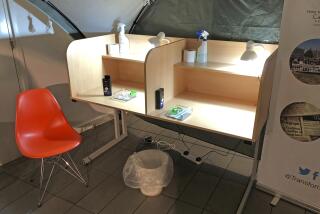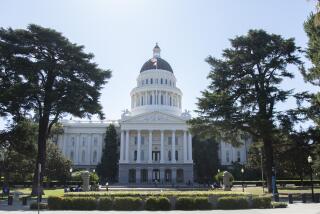Scots Ask of New Parliament, Was It Worth Its Wait in Gold?
- Share via
EDINBURGH, Scotland — Light and airy are not adjectives usually applied to this gray and dour capital. But light and airy are apt words for its effervescent new Parliament building. And the cost also is so lighter-than-air: nearly $800 million, or 10 times the original target.
Who knew that the Scots, of all people, could be so heedless with their purse strings? The bill works out to about $160 for every resident.
After six years of construction and enormous controversy over its site, design and budget, the Scottish Parliament seems as if it was always destined to be hailed by some and railed against by others.
One thing is certain: If Scotland -- which received “devolved” powers from London five years ago, nearly three centuries after losing its independence -- eventually progresses to a free state as some Scottish nationalists would like, it’ll already have a world-class parliament.
And that has irked some Britons -- read, English -- who wonder why Scots feel they need their own lavish parliament when they also sit in the one at Westminster, and hold leading government positions. After all, Chancellor of the Exchequer Gordon Brown, the second-most-powerful man in Britain, is from Scotland, and Prime Minister Tony Blair was born here.
But at the least, the building, at the foot of Edinburgh’s Royal Mile, is bringing smiles to the faces of tourists, who have been investigating its whimsical, free-form shapes and its “Alice in Wonderland” debating chamber in large numbers since its official dedication by Queen Elizabeth II last month.
Some proponents are comparing it to the Guggenheim Museum in Bilbao, Spain, or the Sydney Opera House in Australia -- examples of modern architecture that have become tourist attractions and icons in their own right.
Hard to describe, it is less a building than a campus -- or as its presiding officer called it, “a village.”
There are seven extravagant, somewhat inchoate buildings, made of steel, glass and concrete, native and foreign woods, brushed aluminum and flagstones and granite from across Scotland. Some are shaped like the prows of ships, and others are reminiscent of caverns.
The most spectacular is the debating chamber, with light streaming in and custom-made postmodern desks in light woods in asymmetrical tiers. There are no supporting pillars. The arched ceiling is held up by trusses of downward-pointing oak beams and steel joists, and the windows face onto the Salisbury Crags, the cliff face that looms over the Scottish capital.
Alongside it are four towers, for committees and other parliamentary work, and for executive ministers and their staff.
There is also a building for the MSPs, the members of the Scottish Parliament, that features cozy, contemplative window seats that appear more suited to reading fairy tales than drafting legislation.
Spanish architect Enric Miralles, the principal designer who died in 2000 at age 44 of a brain tumor, never lived to see his vision fulfilled.
Nor did his original client, Scottish First Minister Donald Dewar, the chief executive for Scotland. In some ways, the project seemed star-crossed from the beginning.
Even now, it is receiving contentious reviews from architecture critics, some of whom find the building too inward-looking and disruptive to its surroundings. Others have hailed it as a triumph, praising it as a work of pure genius and imagination.
Is it a flower, a collection of boats or a man-made crag jutting out in answer to the mountain opposite? Actually, it is a bit of all three.
One Parliament member, Margo MacDonald, has derided it as a “minestrone of a building.”
All this has come at a steep price in aggravation.
The original estimate for the building of a parliament was on the order of $75 million. In fairness, that was before officials began to think in terms of creating an international landmark in the center of old Edinburgh.
It also took three years longer than anticipated to build, as both architect and lawmakers were constantly shifting their ideas.
George Reid, Parliament’s presiding officer, acknowledged that they failed to control costs and impose discipline on the construction venture, but he praised the building as an asset to the new Scotland that is emerging.
“We had in mind a kind of fantasy parliament,” said Benedetta Tagliabue, the widow and creative partner of Miralles, whose firm completed his work in uneasy collaboration with the Scottish architectural practice RMJM.
Although the assignment was to incorporate Queensberry House, a Dutch-style historic building dating from the 17th century, Tagliabue said she and Miralles did not want to be slaves to history, but to “explode” it.
“We had a philosophy that history is the same,” she said, that contemporary buildings had equal right to expression and existence as those from past epochs.
She dismissed the idea that the Scots might not actually like it.
“I never lost my faith in that the people of Scotland would love it very much.... Now the building is here and people can look at it and judge for themselves,” Tagliabue said.
Sean Connery, actor and ardent advocate of Scottish independence, agreed to attend the opening ceremony.
After a parade, a bit of Scottish national poetry and the display of the Scottish national symbols, the lawmakers joined in a rendition of Scotland’s most famous song, “Auld Lang Syne.”
“It is a real Parliament building, and it is now up to the [members] to act like real parliamentarians, and it is up to the rest of the country to give them a fair chance to show what they can do,” Connery told the Scottish Press Assn.
Because the initial hopes for devolution have been somewhat muted since 1997, the chamber does not control much outside the realm of healthcare and education.
But Scottish politicians are hoping that the new Parliament building will give Scots a greater sense of nationhood, said Scottish First Minister Jack McConnell.
“It is just possible that the thrill of those early days has been resurrected in our new home,” he said.
Did it cost too much?
Jonathan Glancey, architecture editor for the Guardian newspaper in London, thinks not.
In an article this year, he accused Scottish politicians of taking a “curmudgeonly approach to Miralles’ masterpiece.”
“Look at Barry and Pugin’s Palace of Westminster,” he wrote, referring to the Houses of Parliament in London. “Hugely expensive. Very late. Utterly magnificent. The cost of this great Victorian monument, while painful at the time, has long been forgotten.”
And that, he suggested, will be true in time in Edinburgh too.










